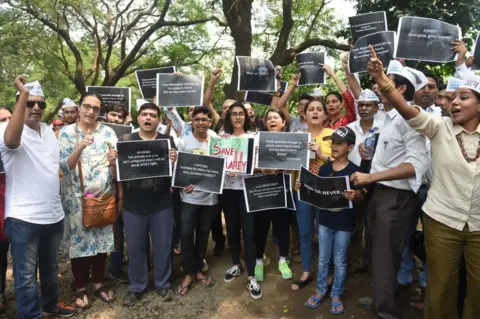Aarey forest: The fight to save Mumbai's last 'green lung'
 Getty Images
Getty ImagesThe Aarey forest, a verdant strip that lies at the heart of India's bustling Mumbai city, is often referred to as its last green lung. But now, locals say, it's under threat from encroachment. BBC Marathi's Janhavee Moole reports.
As a child, Stalin Dayanand used to picnic in the Aarey forest.
"It was the only place where you could go and play, climb trees or just sit and eat under the shade of a tree and be close to nature," says Stalin, who prefers to go by his first name.
Now the 54-year-old is the director of an NGO that works to protect forests and wetlands. He is fighting for Aarey.
On 6 June, the government cleared 40 hectares (99 acres) of the 1,300 hectare forest to build a zoo, complete with a night safari.
Another slice of it is being claimed by Mumbai's new metro rail which is currently under construction. Thousands of trees will have to be felled to construct a new multi-level parking unit for the metro.
Stalin has petitioned India's Supreme Court challenging the construction, but the case is still pending.
Locals and environmental activists like him are up in arms because they fear the government will eventually clear the way for private builders to encroach on the Sanjay Gandhi National Park, which lies to the north of Aarey. Spread over 104 sq km (40 sq miles), this protected area makes Mumbai one of the rare cities to have a jungle within its boundaries.
Their concern is partly fuelled by the fact that this is prime location in a city where land is scarce and real estate prices are among the most expensive in the world.
But officials dismiss these fears as unfounded and point out that the construction for the metro only requires 30 hectares of the 1,300 hectares that make up the Aarey forest.
"This is the most suitable land due to its size, shape and location," says Ashwini Bhide, managing director of the Mumbai metro rail corporation.
 Getty Images
Getty ImagesShe adds that the city badly needs a "mass rapid transport system". India's financial hub is congested and infamous for its crawling traffic jams and its local train system heavily overburdened.
Officials say that the metro will eventually carry around 1.7 million passengers every day and bring down the number of vehicles on the road by up to 650,000. The city's current colonial-era railway system, which is effectively its lifeline, ferries some 7.5 million people between Mumbai's suburbs and its heart on a daily basis.
But they have been up against the city's residents, including activists and conservationists, ever since news emerged in 2014 that trees would be cut to make way for the metro.

Read more India stories

What makes the issue complicated is that the Aarey forest is the site of competing claims.
It's locally known as the Aarey "milk colony" because most of the land was given to the department of dairy development in 1951. But they are allowed to grow cattle fodder only on a fraction of the land. The rest of it is densely forested and dotted with lakes, and the Mithi river flows through it.
Aarey is also home to tribal communities who live in settlements known as "padas".
"We are not getting basic facilities here, and now metro authorities want to take away the jungle which belongs to us too," says Asha Bhoye, who belongs to the Konkani tribe and lives in one of the 29 padas. Plans to relocate some of the tribal communities have also met with resistance and led to protests.
Stalin alleges that instead of declaring the Aarey forest a protected area, the state government has used the opportunity to parcel away pieces of it first to the dairy development department and now to other projects.
 Getty Images
Getty Images"Aarey Forest is part of the same forest as Sanjay Gandhi National Park and we are fighting for the national park itself. In the name of public good, the land is being opened up for developers. It's a systematic effort to destroy the forest."
Activists fear that after the parking units are built, other projects will be permitted, further threatening the area's ecology and wildlife, which includes leopards.
So locals have joined the fight enthusiastically, even leading hikes into the forest to raise awareness. "We bring people here, make them familiar with the forest - there are many species of spiders like trapdoor spiders, the site [of the parking unit] is a leopard site," says Yash Marwa, a screenwriter who is among those campaigning for the forest.
"Mumbai needs to be liveable", he adds. "We need to talk about good quality of air and life before talking about infrastructure and development."
Stalin agrees, saying that "air quality and temperature seem to be last among people's priorities."
But he is determined to not give up.
"If I couldn't do something for my city I'd consider I've failed myself."
